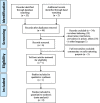Safer tattooing interventions in prisons: a systematic review and call to action
- PMID: 30111364
- PMCID: PMC6094923
- DOI: 10.1186/s12889-018-5867-x
Safer tattooing interventions in prisons: a systematic review and call to action
Abstract
Background: Worldwide more than ten million people are detained at any given time. Between 5 and 60% of people experiencing incarceration report receipt of a tattoo in prison - mostly clandestine, which is associated with risks of blood-borne infections (BBIs). Although safer tattooing techniques are effective in preventing BBI transmission and available to the general population, there is limited knowledge about the impact of safer tattooing strategies in prisons in terms of health outcomes, changes in knowledge and behaviors, and best practice models for implementation. The objective of this research was to identify and review safer tattooing interventions.
Methods: We conducted a systematic review of the literature. Studies of all design types were included if they were published until 27 June 2018, the population was incarcerated adults, they reported quantitative outcomes, and were published in English, French, or Spanish.
Results: Of 55 papers retrieved from the initial search, no peer-reviewed article was identified. One paper from the grey literature described a multi-site pilot project in Canada. Its evaluation suggested that the project was effective in enhancing knowledge of incarcerated people and prison staff on standard precautions, had the potential to reduce harm, provided vocational opportunities, and was feasible although enhancements were needed to improve implementation issues and efficiency.
Conclusions: Although access to preventive services, including to safer tattooing interventions, is a human right and recommended by United Nations agencies as part of a comprehensive package of harm reduction interventions in prisons, this review identified only a few promising strategies for safer tattooing interventions in carceral settings. We call upon governments, criminal justice authorities, non-governmental organizations, and academic institutions to implement safer tattooing projects that adhere to the following guiding principles: i) integration of methodologically-rigorous implementation research; ii) involvement of key stakeholders (incarcerated people, prison authorities, research partners) in the project design, implementation, and research; iii) integration into a comprehensive package of BBI prevention, treatment, and care, using a stepwise approach that considers local resources and acceptability; and iv) publication and dissemination of findings, and scaling up efforts.
Prospero registration: CRD42017072502 .
Keywords: Call to action; Detention; Harm reduction; Human rights; Prison; Safer tattooing; Stepwise approach.
Conflict of interest statement
Ethics approval and consent to participate
Not applicable.
Consent for publication
Not applicable.
Competing interests
The authors declare that they have no competing interests.
Publisher’s Note
Springer Nature remains neutral with regard to jurisdictional claims in published maps and institutional affiliations.
Figures
Similar articles
-
Signs and symptoms to determine if a patient presenting in primary care or hospital outpatient settings has COVID-19.Cochrane Database Syst Rev. 2022 May 20;5(5):CD013665. doi: 10.1002/14651858.CD013665.pub3. Cochrane Database Syst Rev. 2022. PMID: 35593186 Free PMC article.
-
Home treatment for mental health problems: a systematic review.Health Technol Assess. 2001;5(15):1-139. doi: 10.3310/hta5150. Health Technol Assess. 2001. PMID: 11532236
-
Electronic cigarettes for smoking cessation.Cochrane Database Syst Rev. 2022 Nov 17;11(11):CD010216. doi: 10.1002/14651858.CD010216.pub7. Cochrane Database Syst Rev. 2022. Update in: Cochrane Database Syst Rev. 2024 Jan 8;1:CD010216. doi: 10.1002/14651858.CD010216.pub8. PMID: 36384212 Free PMC article. Updated.
-
A rapid and systematic review of the clinical effectiveness and cost-effectiveness of topotecan for ovarian cancer.Health Technol Assess. 2001;5(28):1-110. doi: 10.3310/hta5280. Health Technol Assess. 2001. PMID: 11701100
-
Measures implemented in the school setting to contain the COVID-19 pandemic.Cochrane Database Syst Rev. 2022 Jan 17;1(1):CD015029. doi: 10.1002/14651858.CD015029. Cochrane Database Syst Rev. 2022. Update in: Cochrane Database Syst Rev. 2024 May 2;5:CD015029. doi: 10.1002/14651858.CD015029.pub2. PMID: 35037252 Free PMC article. Updated.
Cited by
-
Blood-borne and sexually transmitted infections: a cross-sectional study in a Swiss prison.BMC Infect Dis. 2018 Oct 29;18(1):539. doi: 10.1186/s12879-018-3445-6. BMC Infect Dis. 2018. PMID: 30373535 Free PMC article.
-
Seroprevalence of hepatitis B and associated factors among inmates: a cross sectional study in the Douala New Bell Prison, Cameroon.Pan Afr Med J. 2021 Apr 13;38:355. doi: 10.11604/pamj.2021.38.355.20386. eCollection 2021. Pan Afr Med J. 2021. PMID: 34367434 Free PMC article.
-
Health Information Seeking Behaviors in Prison: Results From the U.S. PIAAC Survey.J Correct Health Care. 2022 Apr;28(2):90-99. doi: 10.1089/jchc.20.04.0024. Epub 2022 Feb 14. J Correct Health Care. 2022. PMID: 35166577 Free PMC article.
-
Unveiling the Silent Crisis Amidst Tackling Hepatitis B in African Prisons - A Public Health Emergency.Health Sci Rep. 2025 Mar 10;8(3):e70543. doi: 10.1002/hsr2.70543. eCollection 2025 Mar. Health Sci Rep. 2025. PMID: 40066240 Free PMC article.
-
Hepatitis C elimination among people incarcerated in prisons: challenges and recommendations for action within a health systems framework.Lancet Gastroenterol Hepatol. 2021 May;6(5):391-400. doi: 10.1016/S2468-1253(20)30365-4. Lancet Gastroenterol Hepatol. 2021. PMID: 33857445 Free PMC article. Review.
References
-
- Walmsley R. Institute for Criminal Policy Research. 2016. World prison brief.
-
- Butler T, Richters J, Yap L, Papanastasiou C, Richards A, Schneider K, Grant L, Smith A, Donovan B. Sexual health and behaviour of Queensland prisoners with Queensland and New South Wales comparisons. Perth and Sydney: National Drug Research Institute, Curtin University, Perth, and School of Public Health and Community Medicine, University of New South Wales, Sydney, Australia; 2010.
Publication types
MeSH terms
LinkOut - more resources
Full Text Sources
Other Literature Sources
Miscellaneous



